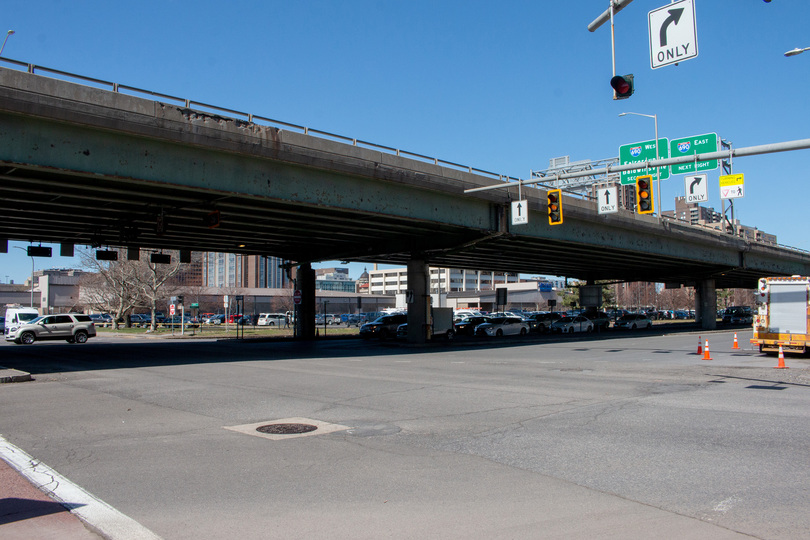Syracuse hires planning firm to study I-81 community grid effects on neighborhoods

Meghan Hendricks | Photo Editor
The city hired a town planning firm to execute a three-phrase study that analyzes state and federal plans for I-81 and makes recommendations focusing on surrounding neighborhoods, Budget Director Tim Rudd said.
There’s still one Orange to root for — The Daily Orange! Donate today and help us win College Media Madness.
Syracuse Common Council approved $550,000 to create a plan for what the city needs to do to better integrate the Interstate 81 community grid plan into Syracuse’s neighborhoods during its meeting Monday.
The council unanimously approved the resolution, which hired town planning firm Dover, Kohl & Partners to execute a three-phase study centering on creating a “Vision Master Plan.” The master plan would analyze state and federal plans for I-81 and make recommendations for what the city should do in surrounding neighborhoods, the city’s budget director, Tim Rudd, said.
“We don’t have a huge urban planning division, so this is our attempt at having our own consultant to give us our own perspective, which will be a unique and different perspective from the state and the feds,” Rudd said. “It’s about having a city-centric voice.”
In 2019, the New York State Department of Transportation announced it would recommend a plan to remove the I-81 viaduct and replace it with a community grid alternative.
Syracuse University Chancellor Kent Syverud announced the university’s endorsement of the plan in 2019. Syracuse community members have advocated for more local hiring opportunities in the project to reconnect the communities that had been displaced by the construction of the viaduct decades ago.
The study, which the firm estimates will take eight months, will focus on the community grid plan’s effects on traffic, the pedestrian experience and community economic development, said Owen Kerney, the city’s assistant director of city planning.
“The vision plan will visualize and facilitate the community’s ambition for I-81 and the city of Syracuse for generations,” he said. “The vision plan will ultimately include proposals for a reconnected street network, including … pedestrian and bike infrastructure … coordination with public transit … affordable housing, as well as implementation strategies.”

Maya Goosmann | Digital Design Director
Phase one of the firm’s work will analyze the state and federal plans and reach out to community leaders, especially those who may be skeptical of the community grid plan, according to the resolution. Phase two creates the vision plan, focusing on the Almond Street corridor, the intersections of Harrison and Adams streets where I-81 passes the university neighborhood and other key intersections along the viaduct. The final phase creates a strategic plan to implement the recommendations generated by phase two’s master plan, the resolution states.
“(This study) is looking at the I-81 project footprint in the city … and developing a plan for how this will not only impact the city, but how the city and this community should react to that huge investment and what strategies there are to do that equitably and effectively,” Kerney said.
The firm will also conduct outreach in the communities surrounding the I-81 viaduct to garner their input. Councilor Rasheada Caldwell wants to make sure the firm also includes community members beyond directly near the viaduct as well.
“The priority has to be to get the community involved,” she said. “This project is going to affect the entire city, all the way from the valley to the west, north, south and east.”
The study will be funded by a portion of the $123 million in American Rescue Plan funds the city received from the federal government.
“I think this is what American Rescue Plan money is for, to look ahead and plan for the future,” Councilor Pat Hogan said. “Obviously, there was no plan when they went through the 15th Ward in the 1960s.”
The community grid replacement plan for the I-81 viaduct will tear down the overpass of the interstate, which separates Syracuse’s Southside from the Eastside, redirecting all non-local traffic around the city via an improved Interstate 481. In the viaduct’s place will be a ground-level and tree-lined street. City officials hope to annex the extra real estate space created by the viaduct’s destruction as well and use it to revitalize the old 15th Ward, which was destroyed when I-81 was built, in collaboration with local nonprofit Blueprint 15.
The community grid plan has received near-universal praise from city and state officials. The 2022 New York state budget contains $800,000 to fund the first phase of construction.
Based in Coral Gables, Florida, Dover, Kohl & Partners has worked on similar projects throughout the country. In New York, the firm has been involved in Rochester’s plans to replace the inner loop section of Interstate 490, Rudd said. The firm was also responsible for the downtown development plan of Richmond, Virginia, in 2008, which also included significant outreach in the community like the Syracuse plan.
Three firms submitted bids for the Syracuse project. Dover, Kohl & Partners was chosen unanimously by the city’s proposals committee, according to city engineer Mary Robison.
“The goal of this project is to ensure that the NYSDOT’s overall community grid alternative project will facilitate the redevelopment of strong neighborhoods that are sustainable and walkable and allow for equitable development within the city once the viaduct is removed,” Robison said in a letter to council.





